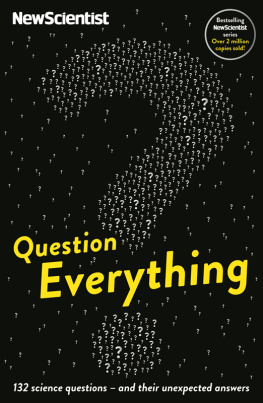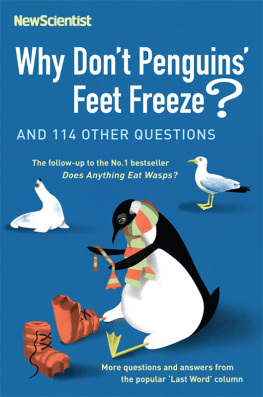Question Everything
132 science questions and their unexpected answers

Question Everything
132 science questions and their unexpected answers
More questions and answers from the popular Last Word column
edited by Mick OHare

First published in Great Britain in 2014 by
Profile Books Ltd
3A Exmouth House
Pine Street
Exmouth Market
London EC1R 0JH
www.profilebooks.com
Copyright New Scientist 2014
The moral right of the authors has been asserted.
All rights reserved. Without limiting the rights under copyright reserved above, no part of this publication may be reproduced, stored or introduced into a retrieval system, or transmitted, in any form or by any means (electronic, mechanical, photocopying, recording or otherwise), without the prior written permission of both the copyright owner and the publisher of this book.
A CIP catalogue record for this book is available from the British Library.
eISBN: 978 1 84765 984 2
Anyone undertaking any of the activities described in this book does so at their own risk. No responsibility for any consequences, however caused, will be accepted by the New Scientist, Profile Books or the individual contributors.
Introduction
The Last Word column in New Scientist magazine the publication in which most of the questions and answers in this book began life has traditionally devoted itself to the trivial. Thats why we know why hair turns grey, why snot is green, and how fat you need to be in order to be bulletproof. And its why this books predecessors have proved to be such a hit with readers. Its our stock-in-trade: finding out how and why the things surrounding our everyday lives do what they do.
But every so often we look at the bigger picture. Well get a question about stuff in the sky, stuff in the outer reaches of the universe or stuff at the atomic level. Not so much trivia as the stories behind why our planet, our solar system and our universe are like they are. Just why is the night sky black even though its full of stars pumping out more light than our sun? Why does Earth rotate? And why is the Large Hadron Collider so, er, large? You can find out all about these and other mega-quandaries in the pages that follow.
Obviously, we also have lots of the usual stuff in here about our bodies, our dinners and the various living things we share the planet with, to keep regular readers happy. You can find out why your legs feel wobbly when you are standing on the top of a cliff or how flies can fly into a window pane without damaging themselves. And theres a lot about booze, of course. Why does ice in whisky create such lovely swirling patterns? Does drinking absinthe make you hallucinate? As we say on the cover: Question Everything.
But this time we set out to make people think a little more about our universe and whats in it, and the physics, chemistry and biology that keep it all on the move.
So, with a big bang, here we go and remember, you can follow the Last Word online at www.newscientist.com/lastword or in print by buying the weekly New Scientist magazine. Questions (and answers) always welcome!
Mick OHare
Special thanks in no particular order to the following: Melanie Green, the New Scientist subs and art teams, Jeremy Webb, Beverley De Valmency, Paul Forty, Andrew Franklin, Eleanor Harris, Drew Jerrison, Nick Heidfeld, Harold Wagstaff, Felipe Massa, Sally and Thomas.
1 Earth
 In a spin
In a spin
What makes Earth rotate?
R. J. Isaacs
Barnet, Hertfordshire, UK
Earth rotates simply because it has not yet stopped moving. The solar system, and indeed the galaxy, were formed by the condensation of a rotating mass of gas. Conservation of angular momentum meant that any bodies formed from the gas would themselves be rotating. As frictional and other forces in space are very small, rotating bodies, including Earth, slow only very gradually. The moon, a much smaller and lighter body, has effectively already stopped rotating because of the gravitational drag exerted by Earth, and now always keeps the same face turned towards us.
Glyn Williams
Derby, UK
Although Glyn Williamss explanation of Earths rotation is correct, his assertion that the moon has effectively already stopped rotating could be misleading. The moon does rotate. The reason why it presents the same face to us is that its period of rotation is the same as its period of revolution around Earth. This equality is the result of tidal friction. If the moon did not rotate, any line through it, parallel to the orbital plane, would keep the same direction in space and the moon would show us its far side during a complete revolution, as one can easily convince oneself by a simple drawing on paper.
D. S. Paransis
Department of Geophysics
Lule University of Technology
Sweden
 Early days
Early days
The shortest day of the year in the northern hemisphere occurs on 21 or 22 December, yet the earliest sunset is on 13 or 14 December and the latest sunrise occurs a similar number of days after the shortest day. Why is this?
John Walker and Alan Whittle
Manchester, UK
Two properties of Earths orbital motion around the sun give rise to the curious disparity between the dates of earliest sunset, shortest day (winter solstice) and latest sunrise. These are the eccentricity of Earths orbit, and the tilt of its equator to its orbital plane.
The combined effect of these is to vary the length of the day throughout the year. In some months, the interval between noons on successive days is slightly greater than 24 hours, while in other months it is slightly less. The differences cancel one another out over the course of a year.
In December, near the northern winter solstice, the interval between successive noons is about 30 seconds less than 24 hours. Because this difference is greater than the daily change in sunrise and sunset times, it becomes the dominant effect, causing the observed separation of the dates of earliest sunset and latest sunrise.
Fred Watson
Coonabarabran, New South Wales, Australia
The main effect of this shifting of latest sunrise to several days after the winter solstice (the shortest day of the year) is an oscillation of the time of day when the sun reaches its highest elevation. The time oscillates about noon in a sine wave with an amplitude of 8.8 minutes at latitude 45 and with a period of 6 months. At the solstices and equinoxes, highest elevation is at noon.
Each day, sunrises and sunsets occur equally before and after the time of the suns highest elevation. If we call those intervals morning and afternoon, then at the winter solstice, the length of morning is at its minimum and so changes very little for a few days. But although the time of the suns highest elevation is noon at the solstice, that time gets later quite quickly and shifts the sunrise so that it falls later for a few days. After those few days, morning begins to get longer and overwhelm the 8.8-minute sine wave so we get earlier sunrises again.
Why does the time of the suns highest elevation oscillate around noon? Mainly because Earths axis is tilted with respect to its orbit around the sun. Fix a frame of reference at the centre of Earth, aligned with the axis of Earth, but rotating uniformly around that axis only once per year, not once per day. In that frame, the sun generally goes up and down by 23 degrees. But it also goes side to side a little, and this gives the oscillation in time of the suns highest elevation each day around noon.
Next page












 In a spin
In a spin